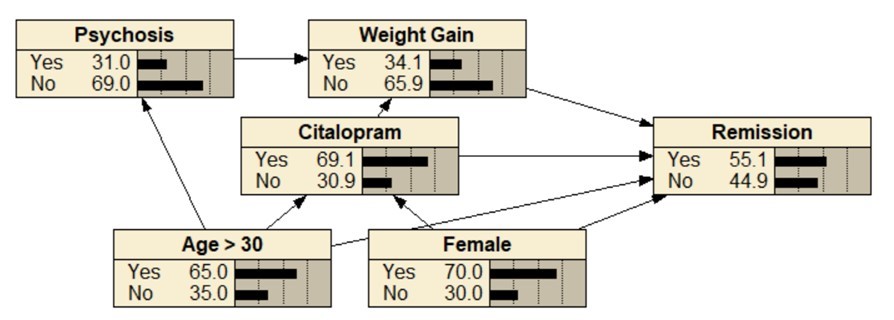Lecture: Do Operation in Causal Networks
Assigned Reading
AssignmentInclude in the first page a summary page. In the summary page write statements comparing your work to answers given or videos. For example, "I got the same answers as the Teach One video for question 1." In one sentence, indicate if your peer-teacher has approved your submission. Question 1: This problem is based on example 1.2.1 in the "Causal Inferences in Statistics: A Premier" book. The following Table gives the recovery rates of 700 patients who were prescribed a drug, half of whom took the medication.
Resources available for Question 1:
Question 2: Organize the data from the previous question into a Netica model, with tables completed. Show how a do operation can be calculated using the Netica software. Resources for Question 2: Question 3: Calculate the causal impact of fever on diagnosis of COVID, using do operation: Resources for Question 3:
Question 4: The following data show the joint distribution of gender, medication taken, and response to the medication (similar to question 1). Keep mind that the conditional probability of taking the medication given the patient's gender is also called propensity score. Conditional probability of x given z is calculated as the joint probability of x and z divided by probability of z.
Resources for Question 4:
Optional Question 5: An adjustment set is a set that allows you to calculate causal impact of exposure/treatment. There are several different ways of identifying an adjustment set. If all parents in the Markov Blanket of exposure are stratified, then the causal effect of exposure on outcome can be measured. This, however, may not be the minimal set. In this problem, you are asked to use to identify the minimal adjustment set for the following graph:
Resources available for answering Question 5
Optional Question 6: Calculate the average treatment effect and the causal impact of citalopram on remission of depression symptoms, using the attached network. Why are these two values different?
Resources for Question 6:
MoreFor additional information (not part of the required reading), please see the following links:
This page is part of the course on Comparative Effectiveness by Farrokh Alemi, Ph.D. Course Home► Email► | |||||||||||||||||||||||||||||||||||||||||||||||||||||||


